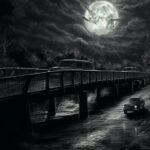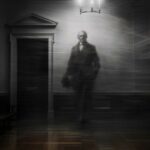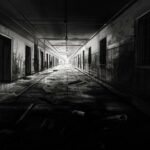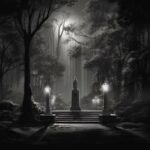Table of Contents
Chicago harbors a dark and eerie past, where shadows linger and whispers of the once-living echo through the streets. Bold adventurers and curious souls explore its haunted realms, seeking encounters with the spectral residents that haunt the city’s most notorious sites. These haunted places offer a chilling glimpse into the Windy City’s history, where every creak and sigh tells a story of mystery and intrigue.
If you are doing any kind of paranormal investigation here, you might want to take a look at our ghost hunting equipment list. Locations like this get a reputation because they are high activity and you don’t need much to see for yourself.
Iroquois Theatre
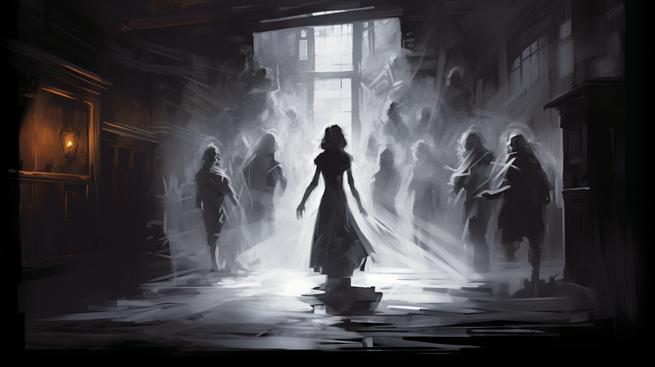
In the heart of Chicago, the chilling legacy of the Iroquois Theatre fire lingers like a specter in the annals of the city’s history. On a cold December day in 1903, what began as a routine matinee performance of “Mr. Blue Beard” at the newly minted theatre turned into an inferno that claimed the lives of 602 unsuspecting patrons. The theatre, which prided itself on being “absolutely fireproof,” became a death trap when flames burst forth, igniting the oil-painted backdrops and consuming the audience in a furious blaze.
The disaster struck a chord of horror throughout the nation, not only due to the harrowing loss of life but also because of the macabre circumstances under which so many perished. The theatre boasted more fire exits than any of its kind, but the doors were found locked—deadbolted to prevent freeloaders from sneaking a free performance. Many met their demise attempting to flee through these doors, only to find them sealed shut.
In the aftermath, the alley adjacent to the theatre was dubbed “Death’s Alley”, an enduring reminder of the day the area became a makeshift morgue for the fallen. Even after the theatre was razed and later resurrected as the Colonial Theatre, and eventually transformed into the Nederlander Theatre, whispers of its tragic past echoed through its halls.
The ghostly tales woven into the fabric of the Nederlander Theatre are as much a part of its character as the ornate fixtures and grand stage. Cast and crew have reported eerie sightings of shadowy figures in the balconies, and the alley behind the theatre is said to be a hotspot for paranormal activity, where some claim to capture inexplicable images along its somber walls.
One particularly haunting account comes from Ana Gasteyer, a former cast member of “Wicked,” who shared her spine-tingling encounter with apparitions of a woman and children, all dressed in the fashion of the early 20th century, standing silently in the theatre’s corridors. These spectral visitors are thought to be the restless souls of those who perished in the fire, eternally replaying their final moments in a loop of otherworldly tragedy.
The Iroquois Theatre fire left an indelible mark on fire safety regulations. This tragic event spurred a sweeping overhaul of public building codes, mandating that exits be clearly marked, doors swing outward, and fire prevention systems be in place. It stands as a solemn testament to the adage that from the ashes of disaster grow the roses of success, with the reformed safety measures being the silver lining to an otherwise dark cloud in Chicago’s history.
Today, the Nederlander Theatre stands as both a hub of entertainment and a monument to the lives lost in the fire. The haunting history of the Iroquois Theatre serves as a stark reminder that sometimes, the show must not go on, especially when the price of admission is far too great.
As I walked through the Nederlander Theatre, once the site of the Iroquois Theatre tragedy, a sudden chill gripped me despite the warmth of the spotlight. I turned to see a woman and children, garbed in antiquated attire, fading in and out of the shadows—a haunting reminder that some curtains never close. Their silent gaze followed me, whispering a ghostly warning that in Death’s Alley, history’s fiery past still treads the boards.
H.H. Holmes’ Murder Castle
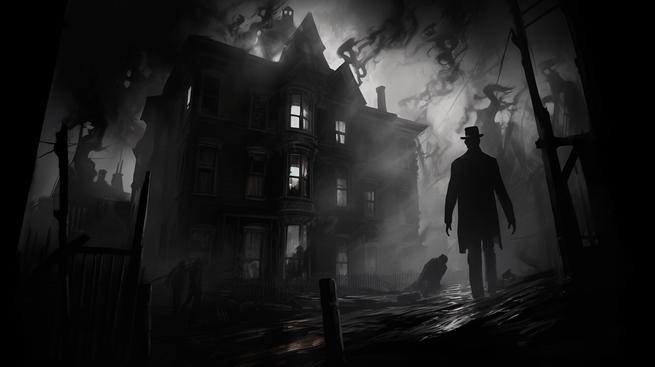
In the heart of Englewood, Chicago, nestled on what is now the site of a U.S. Post Office, once stood the sinister edifice dubbed H.H. Holmes’ Murder Castle. This grim structure was the brainchild of one of America’s first serial killers, Herman Webster Mudgett, better known as H.H. Holmes, whose real-life horrors have woven a tapestry of ghostly legends.
Holmes crafted a labyrinthine den of death, brimming with rooms that bore no escape and gas lines that served his murderous whims. At the turn of the 1890s, he constructed the building with a revolving door of workers, ensuring no single soul could piece together the macabre puzzle of its design.
Underneath the guise of a charming hotelier, Holmes lured unsuspecting victims with the promise of employment and lodging during the bustling World’s Columbian Exposition of 1893. The hotel’s very walls whispered secrets of vanishings, as many who crossed the threshold were never to be seen again. Holmes’s twisted operations in the Murder Castle were not just the stuff of nightmares but also a masterclass in deception, with insurance fraud woven into its very foundation.
The castle’s basement was nothing short of a charnel house, alleged to be equipped with a grotesque array of tools for dissection and disposal. Yet, the line between fact and fiction blurs, as some accounts attribute the tales of torture devices and acid vats to the sensationalist press of the time.
Holmes’s reign of terror came to an end far from his castle, with his capture and subsequent confession to 27 murders—a number as dubious as the man himself, with some of his supposed victims found to be alive and well. His downfall was not wrought by his killings but by a failed insurance scheme that led him to the gallows in 1896.
Today, whispers of the past linger in the basement of the Englewood Post Office, where some believe remnants of the original Murder Castle foundation still exist. Employees and visitors alike speak of eerie encounters, with shadowy figures and unexplained sounds stirring the silence.
Despite the fire that claimed part of the Murder Castle, leading many to believe it had been reduced to ashes, the building stubbornly clung to life until it was finally razed in the 1930s to make room for the postal facility. The story of Holmes and his house of horrors resurfaced in the public eye with the publication of Erik Larson’s “The Devil in the White City,” reigniting fascination with the morbid history of the Murder Castle.
In the annals of Chicago’s haunted history, the tale of H.H. Holmes and his Murder Castle stands as a chilling reminder of the evil that can hide in plain sight, a monument to the macabre that continues to capture the imagination and haunt the present.
I walked through the shadowy halls of the Murder Castle, where H.H. Holmes’ echoes of the past sent shivers down my spine. Every creak and groan of the building made my heart skip a beat, as if the walls still held the whispers of those who met their untimely end. They say curiosity killed the cat, and as I felt the weight of invisible eyes upon me, I wondered if my own curiosity might lead me to join the ranks of restless spirits said to roam this cursed place.
Couch Mausoleum
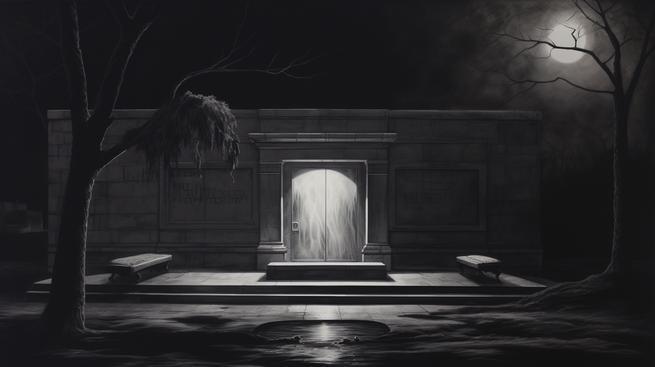
The Couch Mausoleum stands as a lone sentinel at the south end of Lincoln Park, near the Chicago History Museum, its name etched in stone at its peak. This solitary structure is a vestige from the time when this picturesque park served as the city’s original graveyard. The cemetery, which opened its gates around 1843, bid farewell to its last interment in 1866, paving the way for the park’s transformation and its dedication to the memory of the slain President Abraham Lincoln.
The mausoleum holds the name of Ira Couch, a prominent businessman who met his untimely demise while on a sojourn in Cuba during the winter of 1857 at the relatively young age of 50. Prior to his death, Ira Couch, alongside his brother James, had been a beacon of hospitality in Chicago’s burgeoning cityscape. They ran the renowned Tremont House Hotel, which not only provided accommodations but also bore witness to historical figures and events, including speeches by Abraham Lincoln and stays by Stephen A. Douglas and even John Wilkes Booth.
The story of the mausoleum, however, thickens with mystery. When the city cemetery closed its doors, due to alarming sanitary concerns as decomposed remains contaminated drinking water, resulting in cholera outbreaks, the Couch tomb somehow defied the odds and remained. Speculation suggests that the cost of moving the fifty-ton structure may have been too steep a price to pay for the Couch family, leading to its solitary existence amidst the park grounds.
To add to the enigma, it remains uncertain whether the mausoleum still houses the remains of Ira Couch and his kin. No one has peeked inside the tomb since the early 20th century, and while a grandson insisted that several family members should rest within its limestone walls, headstones elsewhere throw a shadow of doubt on this claim. The true residency of Ira Couch and his relatives—whether within the mausoleum or at Rosehill Cemetery—remains a riddle shrouded in the mists of time.
But the tale does not end with unanswered questions of where the dead lay their heads. Ghost stories have woven their way through the fabric of local lore, with whispers dating back to the 1880s. Legend holds that if one stands before the mausoleum at midnight’s chime, invokes the dead thrice, the stone doors will yield and a spectral apparition in white will emerge to greet the living. These tales of the phantom of the Couch Mausoleum continue to stir the imagination and add a chilling chapter to Chicago’s haunted history.
As the clock struck midnight, I stood in front of the Couch Mausoleum, my heart racing with a mix of fear and anticipation. Summoning all my courage, I called out to the dead three times, and to my utter shock, the stone doors creaked open, revealing a ghostly figure draped in white, sending shivers down my spine. The tales were true; the spirits of Lincoln Park had not yet laid their secrets to rest.
Lincoln Park
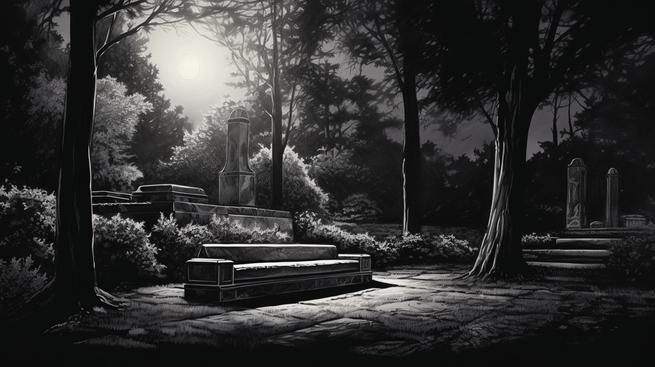
Lincoln Park, one of Chicago’s grand green spaces, holds more than just the laughter of children and the leisurely strolls of city dwellers. Beneath its lush lawns and alongside its meandering pathways lies a spectral past that continues to haunt the present. This park, now a tapestry of nature and urbanity, was once the city’s original cemetery, a final resting place for many of the early residents of Chicago.
In the mid-19th century, as the city grew, concerns over the proximity of the burial ground to Lake Michigan led to the decision to move the graves elsewhere. The city undertook the gargantuan task of relocating the bodies, but the process was cut short by the Great Chicago Fire of 1871. The inferno that engulfed the city also ravaged the cemetery, obliterating headstones and grave markers, casting a shadow of uncertainty over the exact locations of the remaining graves.
Today, visitors to Lincoln Park may walk unwittingly over forgotten sepulchers, the only visible reminder being the Couch Tomb, standing as a silent sentinel to a bygone era. The park has become a cradle of ghost stories, with many locals and tourists claiming to have had eerie encounters or feeling an inexplicable chill down their spine as they traverse the park’s expanse. The whispers of the past seem to echo through the trees, and some say the spirits of those disturbed from their eternal slumber still roam the park, searching for peace.
The legacy of Lincoln Park serves as a reminder that history is often just beneath our feet, and in Chicago, the line between the past and the present is as thin as a wisp of mist on a windy city morning.
As I jogged through Lincoln Park at dawn, the air felt thick with whispers from its original cemetery origins. Suddenly, a chill ran down my spine – it was as if the spirits, disturbed from their rest, were brushing past me, still searching for their lost headstones in the lush lawns. The Couch Tomb loomed in the distance, a stark reminder of the park’s spectral past, making me feel like I was walking on someone’s grave.
Chicago Water Tower
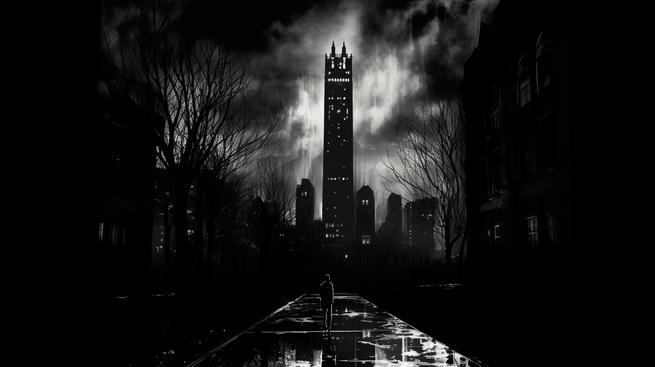
The Chicago Water Tower, a limestone sentinel standing tall since 1869, remains one of the city’s most enduring symbols of resilience. Rising to a modest height of 182 feet, the tower, designed by architect William Boynton, was originally a beacon for the Chicago Fire Department, promising a steady supply of water from Lake Michigan through its 140-foot pipe.
In the wake of the Great Fire of Chicago in 1871, which reduced much of the city to cinders, the water tower stood as a lone survivor amidst the devastation. This event cemented its status as a symbol of the city’s indomitable spirit, making it the cornerstone around which the new Chicago would rise from the ashes.
Over time, the tower underwent renovations, first from 1913 to 1916, and again in 1978, largely focusing on its interior while retaining its historic façade. Its significance in American history was officially recognized when it was listed on the National Register of Historic Places in 1975.
Yet, behind the tower’s stoic exterior lurk tales of hauntings that have woven themselves into the fabric of local lore. The most prominent among these spectral residents is an unknown man who, during the Great Fire, tirelessly manned the pumps in a vain attempt to quell the inferno. Driven to despair as the fire closed in, he is said to have taken his own life in the tower’s upper echelons. His shadowy presence has been reported lurking in the windows, a sight so convincing that it once prompted a police investigation.
But he is not alone; the tower has drawn others to their demise. In 1875, a man named Frederick Kaiser succumbed to his battle with depression, plunging to his death from the tower. His story, a grim tapestry of mental health struggles and a final, fatal act, adds a dark thread to the tower’s narrative. Similarly, in 1881, Hugo Von Malapert, a man burdened by financial woes and a longing for his homeland, met his end in the shadow of the water tower.
These lost souls, including the two German men, are rumored to still roam the premises, their presence an eerie reminder of the tower’s checkered past. To this day, the tower stands as the office for the Chicago Office of Tourism and houses an art gallery, its walls adorned with pieces that pay homage to the city’s storied history.
In conclusion, the Chicago Water Tower not only stands as a testament to the city’s ability to rise from its own ashes but also serves as a spectral repository for the restless spirits of its tragic past. While the tower continues to be a beacon for the living, charting the city’s progress, it also whispers the tales of those who are forever etched in its stones.
I heard the spine-chilling tale of the Chicago Water Tower, where the ghost of an unknown man haunts its limestone walls, a remnant of the Great Fire of Chicago. They say he stayed at his post, fighting the blaze until he couldn’t take it anymore and met his tragic end. Now, his spirit lingers, a grim reminder of that fateful day, still making some believe they’ve caught a glimpse of him peering out from the tower’s windows.
Congress Plaza Hotel
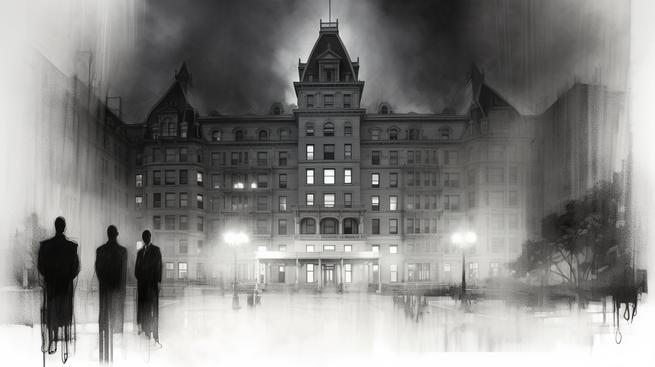
The Congress Plaza Hotel in Chicago stands as a towering testament to the city’s rich tapestry of history—a beacon that has attracted presidents, celebrities, and, if the tales are to be believed, a host of spectral residents who have checked in but never checked out. Known as the granddaddy of haunted hotels in Chicago, the Congress Plaza’s walls are not just steeped in history but also in the paranormal, making it a magnet for ghost hunters and thrill-seekers alike.
Constructed as the Auditorium Annex to accommodate throngs of visitors for the Columbian Exposition of 1893, the hotel, with its opulent ballrooms and lavish accommodations, quickly became the toast of the town, earning the moniker “The Home of Presidents.” From Grover Cleveland to Franklin Roosevelt, the hotel’s regal suites and meeting rooms have played host to a veritable who’s who of American leadership.
However, the Congress Plaza harbors a darker side, one that has given rise to a veritable smorgasbord of ghost stories and chilling encounters. The hotel’s history is marred by tragic events—untimely deaths, suicides, and accidents—that have left an indelible mark on its storied halls. Take, for instance, Room 905, where guests are often unnerved by incessant phone static that seems to have no earthly source.
The hotel’s North Tower is notorious for its spectral activity, with a myriad of rooms that have sent chills down the spines of even the most seasoned ghost hunters. The tales are as varied as they are unsettling: from pictures that spin on the wall to a deceased judge who insists on channeling surfing from the beyond, the North Tower is a hotbed for the unexplained.
One room, in particular, has garnered a reputation that would make even the most skeptical take pause—the infamous Room 666. Shrouded in mystery and permanently sealed off from the world, the room’s very number evokes a sense of dread. Legend has it that the room was closed up with its cursed furnishings still inside, as if to contain the malevolence that dwells within.
Despite its ghostly inhabitants, the Congress Plaza continues to stand tall, a sentinel overlooking Chicago’s bustling streets. It’s a place where the past refuses to be forgotten, where every creak and whisper in the night could be the calling card of a long-departed guest. For those brave enough to delve into its haunted legacy, the Congress Plaza Hotel offers a window into the otherworldly—a chance to walk the fine line between the living and the spectral realms.
I checked into the Congress Plaza Hotel in Chicago, drawn by its spine-tingling reputation, and the second I entered Room 905, a shiver ran down my spine. The incessant phone static that began as soon as I unpacked was enough to make my blood run cold—it was as if someone, or something, was trying to reach out from the other side. By the time I heard the ghostly whispers in the corridor, I knew I was in over my head, dealing with forces beyond my wildest nightmares.





